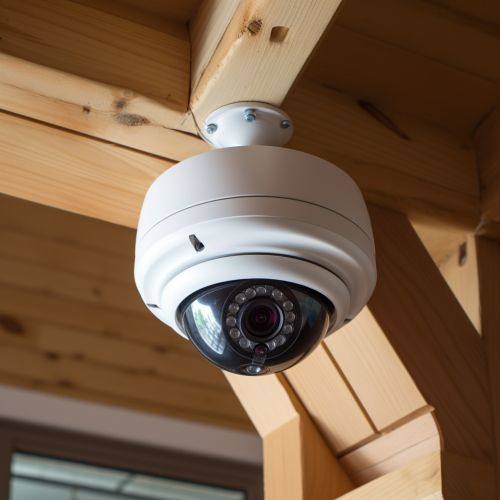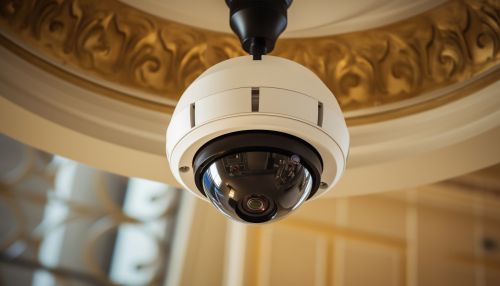Security camera
Overview
A security camera, also known as a surveillance camera, is a device used to monitor and record activities in a specific area for the purpose of maintaining security, preventing crime, and monitoring operations. Security cameras are a key component in video surveillance systems, which are often used by individuals, businesses, and law enforcement agencies worldwide.
History
The concept of surveillance has been around for centuries, but the first mechanical security camera was not developed until the 19th century. The technology has evolved significantly over time, from the early days of analog cameras and VCRs to today's digital cameras and cloud-based storage solutions.
Types of Security Cameras
There are several types of security cameras, each with its own set of features and uses. These include dome cameras, bullet cameras, IP cameras, PTZ cameras, and thermal imaging cameras, among others.
Dome Cameras


Dome cameras are named for their dome-like shape. They are commonly used in retail environments and are designed to be unobtrusive but visible, to deter crime.
Bullet Cameras
Bullet cameras are long and cylindrical in shape, resembling a bullet. They are often used in outdoor environments and are designed to focus on a specific area, such as a doorway or gate.
IP Cameras
IP cameras, or Internet Protocol cameras, transmit video over a network using Internet Protocol. They can be accessed and controlled remotely, making them ideal for remote surveillance.
PTZ Cameras
PTZ cameras, or Pan-Tilt-Zoom cameras, offer the ability to move the camera lens to pan (move left or right), tilt (move up or down), and zoom in or out. This provides greater flexibility in monitoring and recording activities in a larger area.
Thermal Imaging Cameras
Thermal imaging cameras use infrared technology to detect heat and create images based on temperature variations. They are often used in low-light or no-light conditions.
How Security Cameras Work
Security cameras capture video footage of a specific area. The video is then transmitted to a storage device, such as a DVR or NVR, or to a cloud-based storage system. The footage can be viewed in real-time or played back at a later time.
Applications of Security Cameras
Security cameras are used in a variety of settings for different purposes. These include home security, business surveillance, traffic monitoring, crime prevention and detection, and industrial process monitoring.
Legal and Ethical Considerations
The use of security cameras raises several legal and ethical issues, including privacy concerns and the potential for misuse. It is important for users to understand the laws and regulations in their jurisdiction and to use surveillance equipment responsibly.
Future Trends
Advancements in technology are continually shaping the future of security cameras. Trends include the increasing use of artificial intelligence and machine learning for video analytics, the growth of wireless and IP cameras, and the integration of security cameras with other smart devices in the Internet of Things (IoT) ecosystem.
